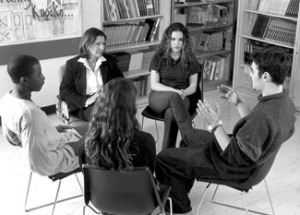In the field of second-language teaching, teaching approaches have come and gone; the approach that has held sway during my teaching career has been the communicative approach, which emphasizes interaction. This approach could be very different from what you experienced if you ever studied a second language in university, where there was a lot of book-learning, but very little real communication.
The communicative approach to second-language teaching seems conducive to a learner-centered approach to teaching in general: because the emphasis is on learners communicating with each other, it is natural to employ activities such as role-plays, incorporate group work and follow the principles of cooperative learning, all of which facilitate communication. Unfortunately, even today, not all language teachers embrace this approach as fully as they could, leading to teaching that is still teacher-centered, with the sage on the stage.
Having taught literature at university when I was much younger, I have experienced teaching from the other perspective, where the focus is on covering the material that is on the course outline, so I empathize with my colleagues who are not language teachers and for whom communication of a language in its grammatical, textual, and functional aspects is not the primary learning outcome, but rather the communication of a field of knowledge is, be it welding, drafting, carpentry, nursing, laboratory technology, aerospace, etc.
Nevertheless, I have gained a lot of insight by considering how learner-centered approaches can enhance my language teaching and the learning of my students. Flipping the classroom, which affords the learner the opportunity to redistribute her time to best take advantage of the merits of studying as an individual and as a group member, is a genuine advancement and has a real benefit for language learners, who can now maximize the opportunity for communication in the group-learning environment (the classroom) while completing accuracy-based tasks independently (at home). Much of this would not be possible without the Internet.
The Internet makes possible other student-centered approaches that are genuine advancements in teaching and learning and can enhance language teaching as well. For example, think of the potential that blogging creates for developing writing skills in second-language learners: the interactive nature of the platform means that the learner communicates not simply with the teacher, but with all the learners who have access to the blog, by virtue of which communication proliferates as posts receive comments and comments on comments ad infinitum.
Inquiry-based learning is another student-centered approach that will significantly enhance language learning in my classroom. At the Language Training Centre, we are uniquely situated insofar as we are affiliated with a college, and so language teaching occurs in the context of getting students ready for academic study. At high levels of proficiency, language learners are expected to demonstrate skills, such as analysis, interpretation and evaluation, that blur the boundaries between communication skills and thinking skills. Posing a problem to learners and asking them to come up with a solution gives learners an opportunity to develop these thinking skills. Inquiry-based learning facilitates the development of these higher-order thinking skills as learners are asked to consider not only what-they-know but how-they-know.
Among student-centered approaches, the flipped classroom, the blog and the inquiry-based project can enhance language learning enormously.















